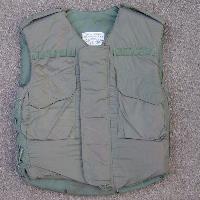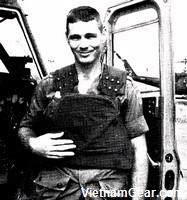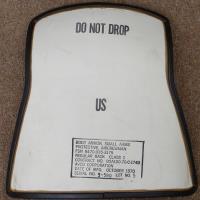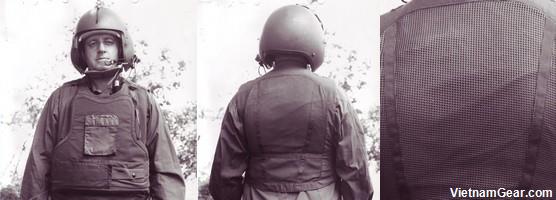Feature: Who are you calling Chicken?
03 July 2006
Vietnam Gear investigates the development of the U.S. Army’s aircrew body armor from the 1962 heavyweight pilots shield through to the 1971 lightweight Nomex mesh back vest.

The M1952A vest provided only fragmentation protection and was useless against small arms fire.
Air Mobility was a key component of America's combat strategy during the Vietnam War, but use of the helicopter had already become prevalent during the advisory period when U.S. personnel were officially non-combatants. For Army pilots conducting low flying reconnaissance missions during that time the only body armor available to them was the WWII flyers flak jacket or the
M1952A fragmentation protective vest developed during the Korean War. Unfortunately the fact that neither provided protection against small arms fire probably contributed to some of America's first casualties in Vietnam being Army helicopter pilots and crew.
The effort to produce body armor to combat the threat of small arms fire began in 1962 when the Army Transportation Research and Engineering Command (TRECOM) fabricated a pilot's shield made from 1-inch thick Doron plating. It was designed to rest on the airman's thighs and at 17½ Pounds weighed twice as much as the M1952A flak vest. The TRECOM shields were included as a component of the H-21 and UH-1 helicopter armor kits sent to Vietnam in January 1963.
Later Hard Face Composite (HFC) TRECOM aircraft armor kits included a pair of Natick Laboratories produced chest shields that were made from a lightweight ceramic composite rather than Doron panels. However, both the Doron and the HFC shields proved too uncomfortable for pilots to wear for any length of time and were rarely used as a result. Natick also fabricated a curved torso shield made from 13 ceramic tiles bonded to a reinforced plastic shell that rested on the seat between the pilot's legs. This new shield, which provided .30 caliber protection at 100 yards at 0
o - 45
o obliquity, was tested in Vietnam by the Advanced Research Projects Agency (ARPA) but was found to interfere with the pilot's operation of the aircraft.

Photo: Natick Laboratories
The T65-1 cloth back carrier was attached to the front torso armor plate by snap fasteners.
In response to the failure of the shield designs Army Material Command (AMC) assigned sole responsibility for the development of aircrew body armor to Natick Labs in August 1964. Natick responded with the production of the experimental T65-1 cloth back carrier that mated to a prototype curved front torso armor unit by means of female snap fasteners. Padded shoulders sections distributed the armor's weight and cloth wrap around straps with a Velcro fastener held the vest-type unit in place.
Natick Labs' Edward Barron and four other members of the AMC armor team visited Vietnam in February 1965 to obtain user reaction to the conceptual armor and found that it was well received. They also discovered that the discomfort of wearing the HFC torso shield was such that pilots and co-pilots preferred exposure to small arms fire! As an interim solution the team shortened an HFC chest protector by 3-inches so that it could be worn with a T65-1 cloth back vest. This field modification was so successful that Military Assistance Command Vietnam (MACV) agreed to establish a program to modify the 500 shields already In-Country and fabricate sufficient cloth back carriers.
As a consequence of the information collected during the 1965 visit, Natick Labs made several improvements to their cloth carrier. The resulting T65-2 vest featured large envelopes to accommodate a front torso protector for pilots or front and rear plates for gunners, who did not have the benefit of armored seats. The new carrier also had a front pocket for maps, webbing rather than non-stretch fabric at the sides and sliding shoulder straps in place of the original snap fasteners. Attached to the outside overlapping waistband was an elastic loop with a snap fastener that prevented opening in the wind stream. Ballistic nylon felt was added to the shoulder padding and to the inner lining of the plate pockets in order to improve spall and fragmentation protection. The new vest opened only at the right shoulder rather than both shoulders, ensuring that the front and back sections remained joined when not being worn.

The Army's aluminum oxide ceramic plates were backed by reinforced plastic, had a front spall shield and rubber edging around the periphery
Improvements were also made to the curved armor plates, which were fabricated using a monolithic ceramic construction instead of multiple ceramic tiles that were vulnerable at the joints. The new ceramic plates were backed by reinforced plastic, had a front spall shield with rubber edging around the periphery and were available in three materials; aluminum oxide (class I), silicon carbide (class II) and boron carbide (class III). The boron carbide and silicon carbide plates weighed 10% and 22% less respectively compared to the aluminum oxide armor, but were 2 to 4 times more expensive. All three plate classes provided protection against 0.30 caliber fire at 0 degree obliquity at 100 yards range.
Users readily approved the new T65-2 carrier and accompanying plates during a second AMC team visit to Vietnam in February 1966 and the vest specification was standardized as MIL-C-43544 in September 1967. Navy, Air Force and Marine Corps airmen were issued with either the silicon or carbide plates with their vests, whilst only Army aircrews received the heavier aluminium oxide armor.
The success of the new aircraft crewmen's body armor was confirmed when a 1967 U.S. Army Vietnam (USARV) report revealed that of a representative sample of 72 injured airmen between July 1966 and June 1967 only 3.6% suffered wounds to the chest or back. However, the study also reported that 30.5% of the airmen wore an M1952A flak vest over or under their torso armor because the spall and fragment protection provided by the T65-2 carrier was inadequate.
Already aware of this vulnerability Natick had incorporated protective enhancements in a similar vest they designed in 1967 for use by Air Force UC-123 crews conducting low altitude defoliation missions in Vietnam. The
"Ranch Hand" vest was made of a layer of ballistic nylon felt sealed in a waterproof envelope and 2 piles of ballistic nylon. This combination successfully defeated spall and shell fragments and reduced the incidence of projectile fragment ricochets. A high collar made from the same felt and ballistic nylon provided improved neck protection.

The 1968 designed vest had quick-release snap fasteners with non-slip buckles on both shoulders. The vests became known as Chicken Plates or Bullet Bouncers.
Natick delivered 20 of the Air Force vests to the Army Concept Team in Vietnam in October 1967 and ACTIV reported in February 1968 that new vest was preferred significantly to the existing body armor. They also recommended the removal of the high protective collar and that quick-release snap fasteners with non-slip buckles be added to both shoulders. Natick implemented ACTIV's suggestions and the
improved vest was made available for procurement in 1969.
In 1971 new high tenacity treated nylon was developed that greatly simplified the construction of the vest by replacing the existing nylon felt and its' waterproof vinyl envelope. As before, gunners and crew chiefs wore the new vest with both front and back plates. However, Natick introduced a new mesh back section for pilots and co-pilots that attached to the front of the carrier with the usual quick-release fasteners and was interchangeable with the standard vest back. In addition to being both lighter in weight and improving airflow to the pilots back, this new section was made from raschel knit fire retardant Nomex.

Photo: The National Archives
The Nomex mesh knit back was interchangeable with the standard vest rear section.
During the development of the airmen's upper torso armor Natick Labs made three attempts to produce leg armor for gunners and crew chiefs in South East Asia. In February 1965 they sent 500 pairs to the region made of dual hardness steel armor that featured thigh and lower leg units joined at the knee by an articulating hinge. Natick took an improved version to Vietnam during the second AMC team visit made using a 1-piece ceramic construction and shaped to conform to the curve of the limbs. The ceramic extremity armor was preferred to the original steel version and more than 300 pairs were delivered to Vietnam during 1967, despite their hindrance to mobility. Finally Natick eliminated the thigh and knee sections and fabricated a new lower leg unit made from a ceramic and fiberglass composite. At 18 Pounds the new unit weighed less than half that of the original steel armor and boasted a foot bracket that transferred the weight form wearer's leg to the ground.
The development of bullet-proof armor for aircrews is a careful balancing act because the need for increased protection generally leads to heavier armor that inevitably compromises aircraft performance. The U.S. Army's rapid and successful evolution of armor for their airmen in Vietnam, from a basic shield to a fire retardant mesh back vest, is a testament to the dedication and ingenuity of its research and development departments.
BibliographyBody Armor For Aircrewmen by Edward R. Barron, Anthony L. Alesi and Alice F. Park. (U.S. Army Natick Laboratories January 1969)
Personnel Armor Handbook by LT R. A. Green, J. A. Parish (U.S. Naval Weapon Laboratory June 1971)
Forecast Of New Releases For Clothing & General Equipment (US Army Natick Laboratories August 1971)
Support To United States Army In Vietnam - Clothing & Organic Materials Vol II (United States Army Material Command Aug 1968)
Military Specification MIL-C-43544. (20 September 1967)
Follow us on


Copyright © VietnamGear.com. All
rights reserved. This material is intended solely for internal use within VietnamGear.com.
Any other reproduction, publication or redistribution of this material without the
written agreement of the copyright owner is strictly forbidden and any breach of
copyright will be considered actionable